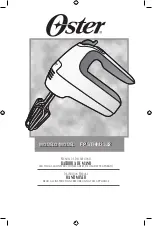
2
FRONT PANEL FEATURES
Level (Channels 1~6):
These controls adjust the
amount of signal sent from the individual input
channels to the mixer output. Optimum Level setting
is near the 12 o'clock position (unity gain).
Level (Master):
This control adjusts the amount of
signal sent from the mixer output to the amplifier
input. The Master Level control is used to adjust the
overall volume of the system.
Low Cut:
This switch inserts a low cut filter at the
amplifier input.
Loudness Contour:
This switch inserts a loudness
filter at the mixer output (+6dB @ 100Hz & +4dB @
10kHz). The Loudness filter provides tonal
compensation when operating with low-level music
signals.
Tone Control:
This switch enables the Bass &
Treble controls.
Bass:
This screwdriver control adjusts the low-
frequencies ("Bass") at the mixer output (±10dB @
100Hz).
Treble:
This screwdriver control adjusts the high-
frequencies ("Treble") at the mixer output (±10dB @
10kHz).
Peak Indicator:
This red LED flashes when signal
levels at the amplifier output have reached
maximum. Occasional flashes of the Peak Indicator
are acceptable, however, a continuously lit LED may
indicate an excessive level setting.
Signal Indicator:
This yellow LED remains lit when
signal is present at the amplifier output.
Fault Indicator:
This red LED lights to indicate fault
conditions due to overheating, DC offset voltage, or
failure of low-voltage power. The Fault Indicator will
light for 3-5 seconds at turn-on, and then go off if no
fault is detected. Some faults (such as overheating)
will correct themselves when the unit has been
turned off awhile. If the Fault Indicator remains lit
when the unit is turned back on, contact your local
dealer.
On Indicator:
This green LED remains lit when AC
power is applied to the unit.
Power Switch:
This switch applies AC power to the
unit.





























